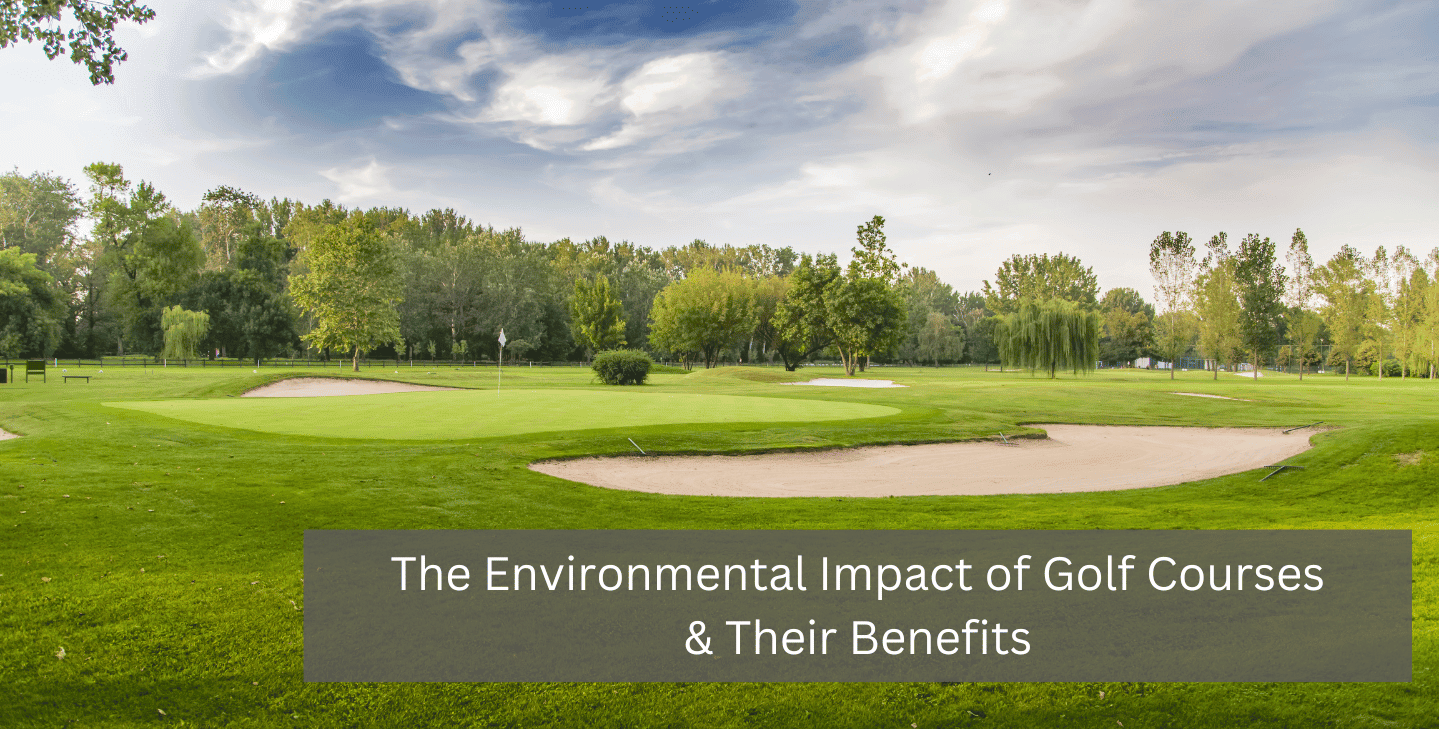The Environmental Impact of Golf Courses & Their Benefits
The Environmental Impact of Golf Courses & Their Benefits
The Environmental Impact of Golf Courses & Their Benefits

Golf courses: are they just vast stretches of manicured greenery for leisure, or can they be allies of the environment? This blog post delves into the dual nature of golf courses—their environmental impacts and the benefits they can offer. While it's true that developing and maintaining these spaces can disrupt local ecosystems, there's a silver lining. With eco-friendly management, golf courses can transform into sanctuaries that support biodiversity, conserve resources, and even combat urban heat. They can turn damaged lands into vibrant ecosystems and serve as green lungs in urban sprawls, offering a breath of fresh air amidst concrete. Join us as we explore how these recreational spaces can strike a balance between providing a venue for sport and acting as stewards of our planet, ensuring that golf courses and nature can thrive side by side.
What Is the Environmental Impact of Golf Courses?
Golf courses are often seen as beautiful escapes, but they carry a hefty environmental price tag. When we build and maintain these courses, we might be stepping on nature's toes—destroying homes for critters and plants, and sometimes pushing local wildlife to pack their bags and move.
But it's not all doom and gloom. Golf courses can be nature's allies, too. Imagine a course designed like a nature reserve, where birds tweet not just on Twitter but in the trees, and where the fairways are a haven for critters. That's possible when golf courses wear the hat of environmental guardians, fostering biodiversity and offering a sanctuary for various species.
However, the quest for the perfect green can sometimes lead to a tug-of-war with Mother Nature. It's like trying to have your cake and eat it too—maintaining immaculate fairways often means reaching for chemicals and using a lot of water, which can ruffle nature's feathers.
The impact of golf courses on our planet calls for a thoughtful look. It's about striking a balance, really. By embracing green practices—think less chemicals and smarter water use—courses can lessen their footprint. It's a team effort, requiring course managers to champion sustainability and create spaces that respect the game and our planet.
In a nutshell, golf courses have the potential to blend the love of the sport with environmental stewardship. With a bit of care and creativity, these spaces can not only serve as playgrounds for golfers but also as preserves that nurture the environment, ensuring that both can thrive side by side.
What Are the Benefits of Eco-Friendly Practices on Golf Courses?
Eco-friendly practices on golf courses offer a range of environmental and community benefits:
- Enhanced Environmental Stewardship: These practices help conserve natural resources and reduce the impact on the land, balancing recreation with nature conservation.
- Carbon Footprint Reduction: Eco-friendly golf courses with well-maintained turf absorb carbon dioxide, acting as carbon sinks and helping to offset the sport's carbon footprint. The article "Carbon Sequestration in Turfgrass–Soil Systems" from PMC explores how turfgrass systems, including golf courses, can act as carbon sinks or sources. It highlights that while turfgrass areas like fairways and roughs can sequester carbon, intensively managed zones like golf greens may not due to high maintenance practices. Proper management can enhance turfgrass's carbon sequestration potential, contributing positively to the environment by storing carbon in the soil and biomass, offsetting greenhouse gas emissions (1).
- Biodiversity Support: By conserving natural habitats and using course roughs and trees, eco-friendly golf courses provide habitats and food resources for various species, thereby supporting biodiversity.
- Urban Heat Island Mitigation: The green spaces of managed golf courses have a cooling effect, which helps combat urban heat islands and can contribute to regional climate control.
- Land Restoration: Eco-friendly golf courses can rehabilitate damaged land, such as former industrial sites, transforming them into thriving ecosystems that benefit the environment and the community.
- Community and Player Benefits: Clean air, conserved water, and a beautiful setting – it's a win-win for everyone. Golfers get to enjoy their game in a pristine environment, and the community reaps the benefits of a healthier, greener space.
- Educational Opportunities: Sustainable golf courses act as educational platforms, demonstrating how eco-friendly practices can be integrated into recreational spaces and promoting their adoption in the golfing industry and beyond.
In summary, when golf courses adopt eco-friendly practices, they're not just upping their game; they're making a lasting impact on our planet and communities, proving that sports and sustainability can go hand in hand.

In What Ways Do Golf's Green Contributions Enhance the Environment?
Golf courses are more than just playgrounds for the sport; they're eco-warriors in their own right when they embrace green practices. Let's break down their environmental scorecard:
Guardians of the Ecosystem: By focusing on sustainability, golf courses act as vital green spaces that enhance the ecosystem's health, playing a significant role in environmental enhancement.
The Cool Factor: On a hot day, there's nothing like the oasis of a well-kept golf course. These green expanses are not just eye candy; they're nature's air conditioners. By dialing down the heat, especially in cosy residential neighborhoods, they're taking a swing at the urban heat island effect. A study in "Frontiers in Energy Research" examines the cooling effects of urban vegetation, focusing on golf courses. It finds that golf courses significantly reduce urban land surface temperatures, with the second lowest temperatures after conservation lands. Key factors like proximity to water bodies and vegetation structure, particularly tall trees and large vegetation patches, are crucial in enhancing these cooling effects. This research underscores the potential of golf courses in mitigating urban heat, suggesting that strategic vegetation management within golf courses can further benefit urban environments (2).
A Safe Haven for Wildlife: Golf courses are the unsung heroes for wildlife. With their strategic roughs and towering trees, they provide a buffet and shelter for a diverse crowd of animals. It's like hosting a nature party where everyone's invited, fostering biodiversity and keeping the ecological balance in check.
Breathing Spaces in Concrete Jungles: In the hustle and bustle of city life, golf courses are like a deep breath of fresh air. They tackle air pollution, sift out contaminants, and manage rainwater like pros. It's as if they're the green lungs of urban and suburban areas, making sure the community gets a dose of clean, fresh air.
Boosting Biological Diversity: These green havens are not just about leisure; they're pivotal in weaving the fabric of biological richness across regions. They stitch together a tapestry of green spaces, essential for keeping the environmental balance just right, ensuring that our neighbourhoods are not just habitable but lively and vibrant.
By championing eco-friendly practices, golf courses do more than offer a playground for golf enthusiasts. They step up as significant players in the environmental field, enhancing ecosystem health, cooling our cities, providing refuge for wildlife, purifying our air, and enriching the biological diversity of our communities. It's a game where everyone wins, with nature scoring the final hole-in-one.
How Can We Adopt Sustainable Measures in Golf Course Development?
Embracing sustainable measures in golf course development isn't just a trend; it's a necessity. It's about crafting spaces that respect our planet while offering a great game.
First up, let's talk tech. Using energy-efficient machinery and tapping into renewable energy, like solar power, isn't just smart; it's a game-changer. Imagine mowers and carts powered by the sun! And when it comes to building, choosing materials with low embodied energy and high recycled content is like choosing the best club for a tricky shot – it makes all the difference.
Designing a golf course? Let's make it a natural beauty. Harmonizing the landscape, preserving ecosystems, and keeping the land as untouched as possible is the way to go. It's like designing a course that's a slice of nature, where every hole is a nod to the environment.
Now, let's ditch those synthetic chemicals. Opting for integrated pest management and organic products keeps the course healthy and green in more ways than one. It's about being kind to the land that gives us our fairways and greens.
Building facilities? We're doing it sustainably, adhering to eco-friendly codes. And let's not forget the power of plants. Planting native species and creating wildlife habitats is like giving nature a VIP pass to the course. Plus, it's a win-win – more birds and butterflies to admire as you play.
Water is precious, so let's use it wisely. Fine-tuning irrigation, choosing drought-resistant flora, and using alternative water sources like treated effluent or stormwater are smart moves. And native landscaping? It's not just beautiful; it's a maintenance lifesaver.
By following sustainable golf development guidelines, we're not just building courses; we're crafting green sanctuaries. It's about setting a standard, showing that golf can be a steward of the environment. So, let's tee off towards a future where every course is a testament to sustainability.
Is Solar-Powered Autonomous Golf Course Mowers the Future?
In the realm of golf course upkeep, solar-powered autonomous mowers are making a significant mark. These mowers aren't just a step forward; they're a leap into a new era of maintenance, blending efficiency with sustainability. They're revolutionising the way we care for golf courses by reducing labour, cutting costs, and championing environmental responsibility. With their ability to navigate autonomously and powered by the sun, these mowers are setting new standards in golf course maintenance. Are they the future of golf course care? Dive into the details on our dedicated page about 'The Future: Solar-Powered Autonomous Golf Course Mowers' and see how they're shaping a greener, more efficient future in golf course management.
FAQ's
Golf courses can significantly affect the environment. They can destroy habitats, push away native animals, and alter local ecosystems through their building and upkeep. Using a lot of chemicals and water can make these issues worse, potentially creating problems for wildlife and impacting things like animal movement and water quality underground.
Absolutely, golf courses can be environmentally beneficial if they're managed thoughtfully. Using eco-friendly approaches, they can protect nature, offer homes for local wildlife, soak up CO2, save natural resources, fight against urban heat, and help with climate regulation. They can even transform damaged areas, like old mines, into vibrant ecosystems.
In urban areas, golf courses can cool down the environment, tackling the urban heat island effect. They act as green oases, cleaning the air, filtering out pollutants, and handling rainwater. Besides offering a place for leisure and mental well-being, they help people appreciate nature, provide habitats for animals, and add to the area's biodiversity and ecological health.
To boost their green credentials, golf courses can adopt practices that protect native wildlife, reduce water use, avoid harmful chemicals, create spaces for animals, and use land wisely, like repurposing old industrial sites. Educating those in the golf industry about these practices is crucial for reducing their environmental footprint and ensuring they care for their land responsibly.
Conclusion
In wrapping up, it's clear that golf courses have a complex relationship with the environment. They're not just areas for sport; they have the potential to be significant players in environmental conservation. By adopting eco-friendly practices, golf courses can reduce their ecological footprint, support diverse wildlife, and offer serene green spaces for communities. They can cool down our cities, clean our air, and even restore damaged ecosystems. It's all about making conscious choices to ensure that these spaces contribute positively to our planet. So, the next time you're enjoying a game of golf, remember that the course beneath your feet could be more than just a playground—it could be a vital piece of the puzzle in our journey toward a more sustainable and environmentally friendly future.
Reference List
(1) Wang R, Mattox CM, Phillips CL, Kowalewski AR. Carbon Sequestration in Turfgrass-Soil Systems. Plants (Basel). 2022 Sep 22;11(19):2478. doi: 10.3390/plants11192478. PMID: 36235344; PMCID: PMC9571228.
Research licensed under CC BY 4.0 DEED.
No changes were made to the material.
---------
(2) Nguyen, T.T.; Eslick, H.; Barber, P.; Harper, R.; Dell, B. Cooling Effects of Urban Vegetation: The Role of Golf Courses. Remote Sens. 2022, 14, 4351. https://doi.org/10.3390/rs14174351
Research licensed under CC BY 4.0 DEED.
No changes were made to the material.
